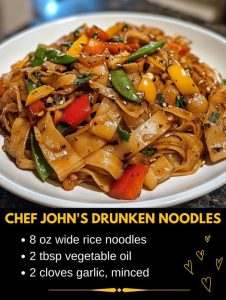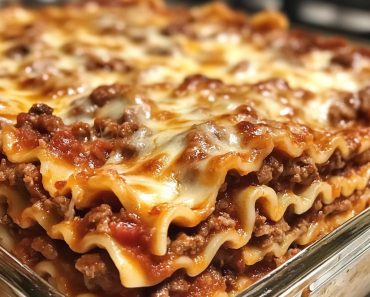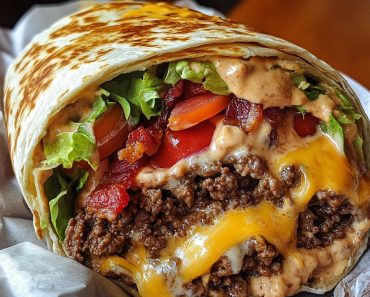
🌸 Embrace Tranquility with Our Comforting Drunken Noodles Recipe 🌸
Imagine an evening where you can savor the bold, fragrant flavors of Thai cuisine right from your own kitchen. Drunken noodles, or “Pad Kee Mao,” is a harmonious blend of spicy, sweet, and umami tastes, combined with tender rice noodles and fresh vegetables. This recipe is inspired by Chef John’s take but with a personal touch to enhance both flavor and relaxation. Dive in, and let’s make this culinary journey both exciting and calming.
Ingredients Overview
Creating a balance of taste and texture is key to this dish. Let’s break down each ingredient and how it plays into the overall profile of Drunken Noodles:
- Wide Rice Noodles (8 oz): These flat noodles soak up flavors beautifully and offer the perfect chewy texture. Look for fresh or dried varieties labeled as “wide” for authenticity.
- Vegetable Oil (2 tbsp): Neutral oil ensures no interference with the spices, making it ideal for high-heat cooking.
- Garlic (2 cloves, minced): Garlic releases its aroma and essence when cooked, lending depth and warmth.
- Bell Peppers (1/2 each of red and yellow, sliced): A pop of color and sweetness, bell peppers add crispness to the dish.
- Onion (1/2, sliced): Sweetens as it cooks, helping to balance the dish’s spicier elements.
- Snap Peas (1/2 cup): Crunchy and mildly sweet, snap peas add an additional layer of texture.
- Sauces:
- Soy Sauce (1/4 cup): Essential for that umami base flavor.
- Oyster Sauce (2 tbsp): Adds a touch of sweetness and depth, enhancing the savory taste.
- Fish Sauce (1 tbsp): Infuses a subtle but crucial saltiness that’s classic in Thai dishes.
- Sugar (1 tsp): Balances the salty and spicy ingredients.
- Red Pepper Flakes (1/4 tsp): Gives a gentle heat. Adjust to taste if you prefer a stronger kick.
- Thai Basil Leaves (1/4 cup): The star herb, lending its unique anise flavor that takes the dish from delicious to extraordinary.
Step-by-Step Cooking Instructions
1. Prepare the Rice Noodles
- Begin by cooking the noodles according to the package instructions. Keep an eye out for just the right level of tenderness—soft but with a slight chew. Drain and set them aside to prevent overcooking.
2. Heat the Oil and Add Garlic
- In a large skillet or wok, heat the vegetable oil over medium-high heat. Add the minced garlic and stir until it becomes fragrant and golden—about 30 seconds. This quick sauté brings out the full flavor of the garlic without bitterness.
3. Add Bell Peppers, Onion, and Snap Peas
- Next, toss in the sliced bell peppers, onions, and snap peas. Stir-fry these until they’re just tender-crisp, usually around 3-4 minutes. You want the vegetables to retain a slight crunch for added texture.
4. Combine the Noodles
- Add the cooked rice noodles to the skillet, gently tossing with the vegetables so they don’t break. Keep the heat at medium-high for that ideal stir-fry texture.
5. Mix and Add the Sauce
- In a small bowl, whisk together the soy sauce, oyster sauce, fish sauce, sugar, and red pepper flakes. Pour this over the noodle-vegetable mixture, stirring everything until each ingredient is coated with that rich, savory sauce.
6. Finish with Thai Basil
- Add in the Thai basil leaves, stirring for an additional 2-3 minutes until the leaves begin to wilt. This final touch releases the basil’s aromatic oils and enhances the dish with its signature taste.
🌿 Tips for a Seamless Cooking Experience
- Choose Fresh, Quality Ingredients: Fresh Thai basil, bell peppers, and snap peas make a noticeable difference in taste.
- Pre-Mix the Sauce: To keep the cooking process smooth, mix your sauces in advance.
- Quick Stir-Frying: Keep everything moving in the pan to ensure even cooking and prevent burning.
- Adjust Spice Levels: If you enjoy extra heat, consider adding fresh Thai chilies or more red pepper flakes.
Storage and Reheating Tips
- Storage: Store any leftovers in an airtight container in the refrigerator for up to 3 days. Keep the Thai basil separate, as it can lose flavor over time.
- Reheating: Warm gently in a pan over medium heat with a splash of water to prevent sticking. Avoid microwaving, as it can alter the texture of the noodles.
📘 Frequently Asked Questions
1. Can I use other types of noodles?
Yes! Udon, soba, or even spaghetti noodles work in a pinch, though rice noodles maintain authenticity.
2. What if I can’t find Thai basil?
Sweet basil is a good substitute, though it has a milder flavor.
3. Is there a vegetarian alternative for fish sauce?
Try using a mix of soy sauce and a bit of mushroom powder for depth.
4. How can I make the dish spicier?
Add extra red pepper flakes or a diced Thai chili pepper.
5. Can I add protein to this dish?
Absolutely! Tofu, chicken, shrimp, or beef are all delicious options.
6. What’s the best oil for stir-frying?
Neutral oils like vegetable or canola oil are ideal.
7. How do I prevent noodles from sticking?
Drain the noodles well and toss them with a little oil if they’ll sit for a bit before use.
8. Can I make this gluten-free?
Use tamari instead of soy sauce, and ensure your oyster sauce is gluten-free.
9. Why are my vegetables soggy?
Keep the heat high and stir-fry quickly for crisp-tender veggies.
10. Is there a way to reduce sodium?
Try low-sodium soy sauce, and go light on the fish sauce.
…and more FAQs covering ingredient substitutions, adjusting sweetness, protein variations, etc.
🌟 Secrets for Culinary Perfection 🌟
1. Use fresh Thai basil for authentic flavor.
2. Keep ingredients prepped and ready before you start.
3. Don’t overcrowd the pan.
4. Stir-fry at a high heat to lock in flavors.
5. Adjust spices to match your taste.
6. Avoid overcooking noodles by timing carefully.
7. Cut vegetables into uniform sizes for even cooking.
8. Try adding a dash of lime for brightness.
9. Experiment with other protein options like tofu or shrimp.
10. Keep stirring to prevent sticking and burning.
…and more insights to make this your perfect homemade version.
Let this recipe inspire a delightful evening in your kitchen, where the simple joy of cooking a dish like Drunken Noodles brings comfort and calm. Enjoy each step, and soon you’ll have a meal that’s not only full of flavor but also beautifully captures the essence of relaxation through cooking




















